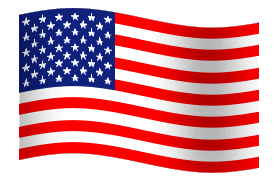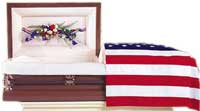
Betsy Ross and the American Flag
Please note: Our site contains the flag code in its entirety and dozens of answers to a very wide array of questions. We hope the information we have provided will be a useful resource to visitors. We are not expanding this section and cannot answer specific questions regarding the flag code and its interpretation.
Funeral Flags
The Flag Code makes no reference to this use. There is a difference of opinion. Some feel that once folded, it should remain so forever. Other experts feel that it would be an honor to display the flag again to show patriotism. Casket flags are 9-1/2'x5' which is almost twice larger than the usual 5'x3' house flag.

- Closed Casket: When the flag is used to drape a closed casket, it should be so placed that the union (blue field) is at the head and over the left shoulder of the deceased. It may be said that the flag is embracing the deceased who in life has served the flag.
- Half Couch (Open): When the flag is used to drape a half-couch casket, it should be placed three layers to cover the closed half of the casket in such a manner that the blue field will be the top fold, next to the open portion of the casket on the deceased's left.
- Full Couch (Open): When the flag is used to drape a full-couch casket, it should be folded in a triangular shape and placed in the center part of the head panel of the casket cap, just above the left shoulder of the deceased.
During a military commitment ceremony, the flag which was used to drape the casket is held waist high over the grave by the pallbearers and, immediately after the sounding of "Taps," is folded in accordance with the instructions given at the top of this page.
This custom began during the Napoleonic Wars (1796-1815). The dead carried from the field of battle on a caisson were covered with a flag.
A casket flag is 9-1/2' x 5'.
Sources: Application For United States Flag For Burial Purposes 21-2008 | Customs (Arlington Cemetery)
It is appropriate for any patriotic person to make and be granted the same honor as military to have a flag drape the coffin. Only those who served in the military, however, are provided the flag for free. It would be recommended that during the service that it be explained that the flag is draping the coffin as an expression of the deceased's patriotism and love of country.
The flag for one who dies on active duty is provided by one's branch of service. Flags for other Veterans are provided by the Department of Veterans Affairs.
Civilians must purchase the flag at their own expense.
There is a tradition to bury a war veteran with a small flag or should it be requested, it is proper for a veteran to be buried with his or her body wrapped in the flag.
Source: USAF Honor Guard Basic Protocol, Honors, and Ceremonies L5AZO8G000 [pdf]
For more information about veterans' funerals, click here.
According to Major Robert A. Lynn, USMCR, the three spent cartridges are symbolic. During a lull in battle, both sides would fire three volleys each and then would remove their dead from the field of battle.
To honor the memory of their service to their country, a United States flag drapes the casket of deceased veterans. The field of blue is at the head and over the left shoulder. After Taps is played, the flag is carefully folded into the symbolic tricorner shape. The folded flag is then presented as a keepsake to the next of kin (see below).
U.S. Air Force: "On behalf of the President of the United States, the United States Air Force, and a grateful nation, please accept this flag as a symbol of our appreciation for your loved one's honorable and faithful service."
U.S. Army: "On behalf of the President of the United States, the United States Army, and a grateful nation, please accept this flag as a symbol of our appreciation for your loved one's honorable and faithful service."
U.S. Marine Corps: "On behalf of the President of the United States, the Commandant of the Marine Corps, and a grateful nation, please accept this flag as a symbol of our appreciation for your loved one's honorable and faithful service."
U.S. Navy: "On behalf of the President of the United States, the United States Navy, and a grateful nation, please accept this flag as a symbol of our appreciation for your loved one's honorable and faithful service"
U.S. Coast Guard: "On behalf of the President of the United States, the Commandant of the Coast Guard, and a grateful nation, please accept this flag as a symbol of our appreciation for your loved one's service to Country and the Coast Guard."
Note: Different branches of the armed services used different wording for funeral services until 2012 when the Department of Defense standardized the wording for the Army, Navy, Air Force and Marine Corps. The United States Coast Guard has been invited to use the same language. For more details, please see:
Military Funeral Honors and Military Cemeteries: Frequently Asked Questions
If the next of kin wishes (ask first), add: "God bless you and this family, and God bless the United States of America."
At the end of the ceremony, the flag is presented to the next of kin (see next), usually by the military chaplain.
Primary Next of Kin (PNOK)
- Spouse
- Sons or daughters in the order of age, oldest first
- Oldest parent, unless legal custody was granted to another person
- Blood or adoptive relative granted legal custody
- Brothers or sisters in the order of age, oldest first
- Oldest grandparent
- Other relative in accordance with laws of deceased's domicile
- Close friends and associates
Note: If the deceased was serving on Active Duty, he/she would have appointed a PNOK in writing, for notification.
Flags for Veterans
Flags are provided for burial services of Servicemembers and Veterans. The flag for one who dies on active duty is provided by one's branch of service. Flags for other Veterans are provided by the Department of Veterans Affairs.
See Laws Relating to Funeral Honors for more information.


